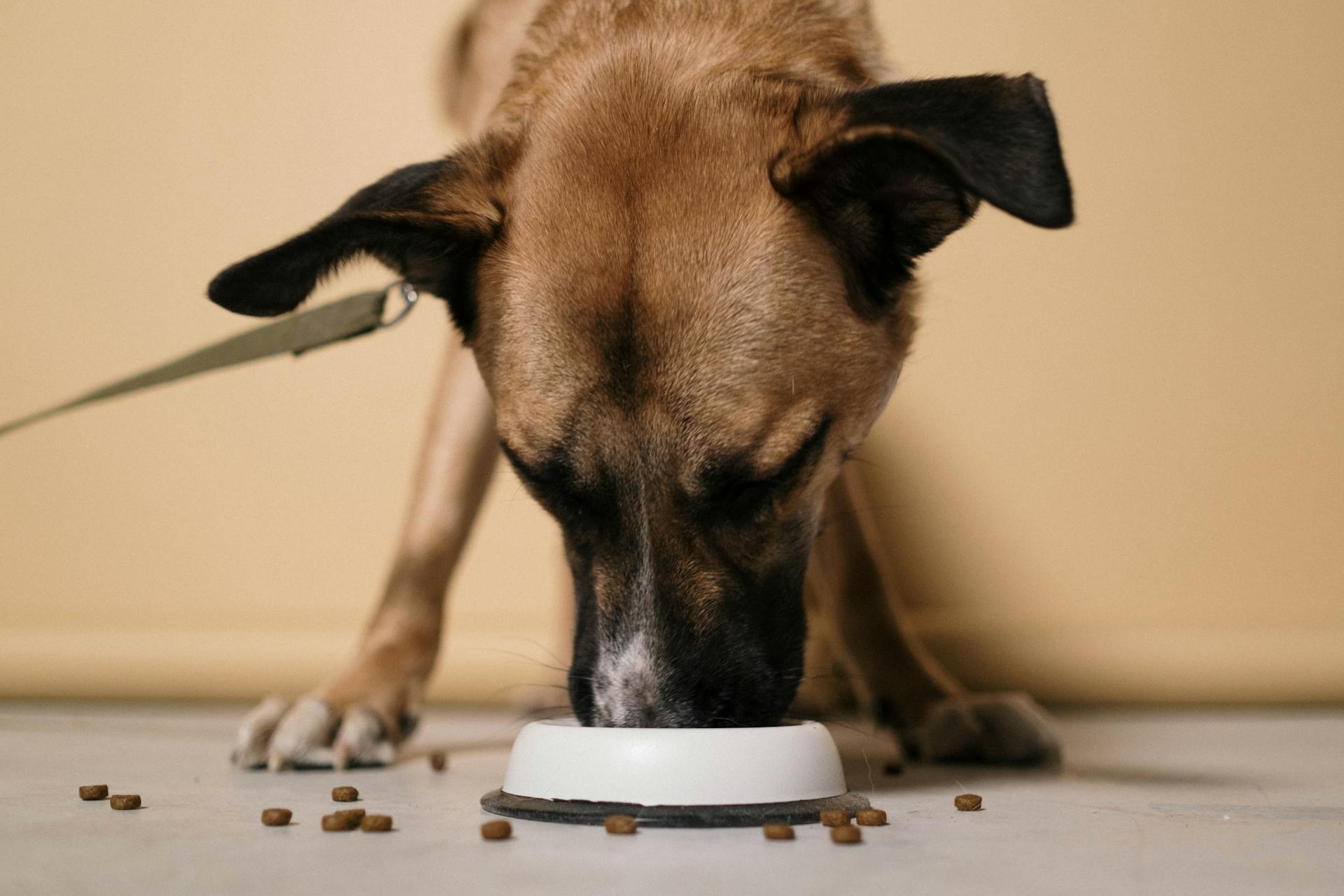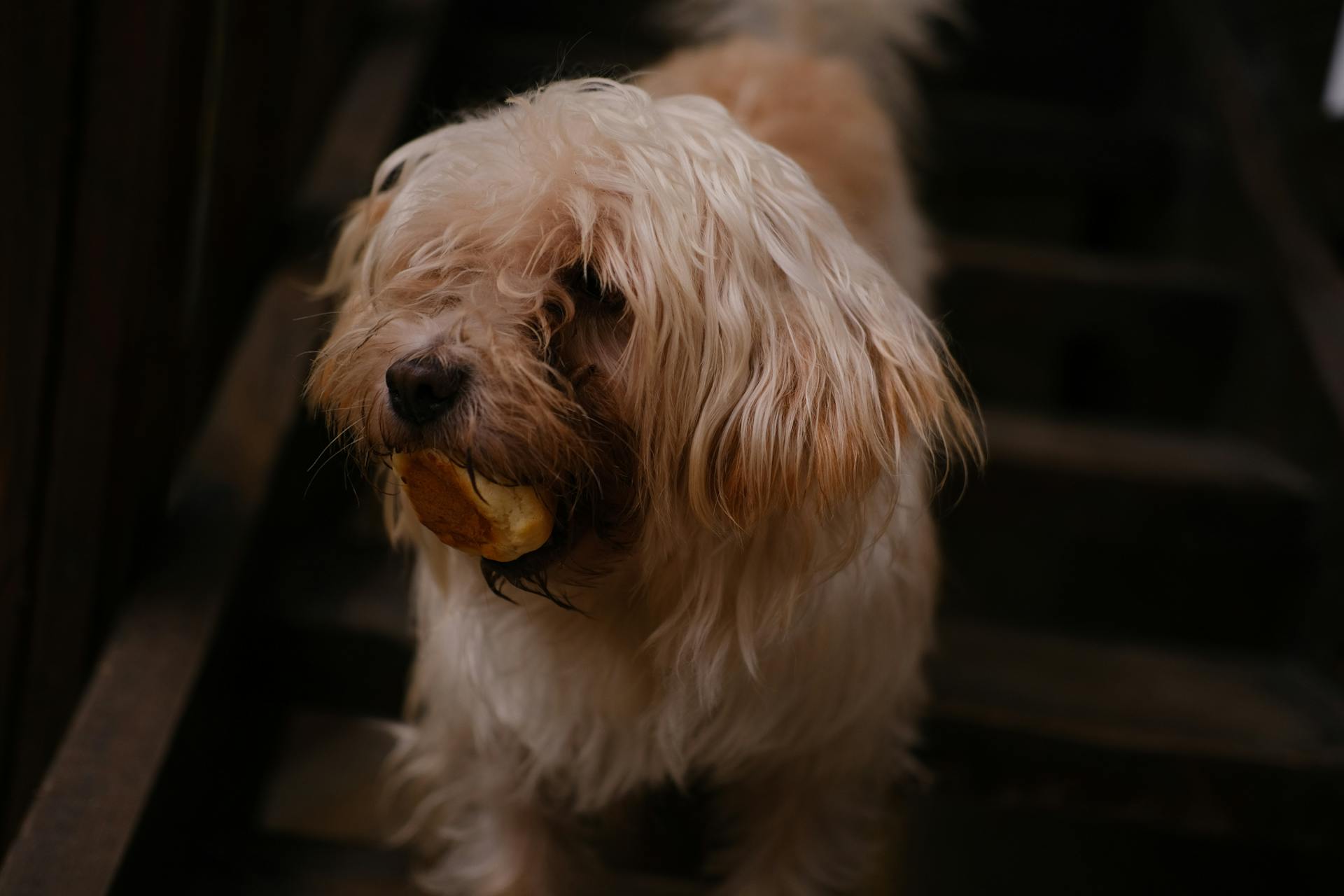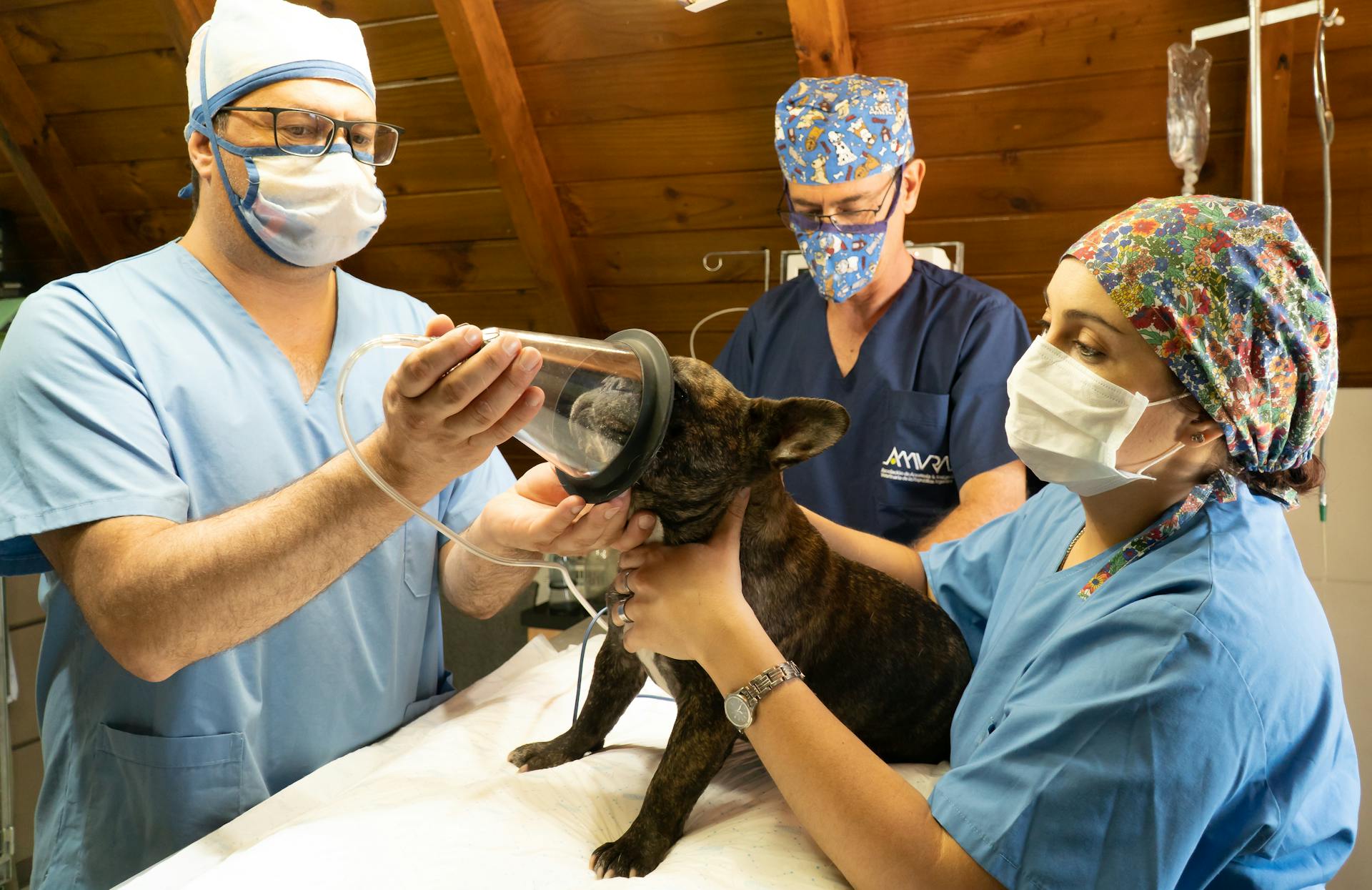
Dog bloat, also known as gastric dilatation-volvulus (GDV), is a life-threatening condition that affects dogs of all ages and breeds.
Symptoms can appear suddenly, often within 2-3 hours after eating, and may include restlessness, pacing, drooling, and a swollen abdomen.
A dog's stomach can expand to 10-15 times its normal size, putting pressure on the esophagus and cutting off blood flow to the stomach.
If left untreated, GDV can lead to organ failure and death within 2-4 hours.
See what others are reading: Dog Names for 2 Dogs
What Is Dog Bloat?
Dog bloat is a life-threatening disorder that happens when a dog's stomach fills with gas and becomes twisted. It mainly occurs in deep-chested breeds.
Bloat can happen in just a few hours if left untreated, making it a rapidly progressing and fatal condition. This condition is most commonly seen in dogs older than 5 and large breeds.
Dogs with chests larger than their waists, also known as deep-chested dogs, are at a higher risk of bloat. Lean dogs with this characteristic can also be at risk.
Bloat happens when a dog's stomach fills with air or fluid and then twists on itself, cutting off the blood supply to the stomach.
Explore further: Dog Breeds Watch Dogs
Causes and Risk Factors
Dog bloat can occur at any age, but it's most common in middle-aged dogs, with risk increasing 20% per year of age.
The American College of Veterinary Surgeons reports that nearly all breeds have been affected by gastric dilatation, but large breed dogs with deep chests are most prone to bloat.
Dogs with a high "height to width ratio" are more likely to bloat, and Great Danes are 5 to 8 times more likely than dogs with a low ratio.
Eating habits can also contribute to bloat, including eating very quickly, overeating, and drinking a large quantity of water in a short period of time.
Raised food bowls can also increase the risk of bloat.
Stress, whether from anxious behavior or stressful situations, can also make dogs more prone to bloat.
Genetic factors, increased age, and exercising after eating can also contribute to the risk of bloat.
Here are some risk factors that can put your pet at risk:
- A family history of bloat
- Eating rapidly
- A single large meal once a day
- Food that’s been moistened
- Elevated bowls
- Food (especially dry) that has a high-fat content
Dogs over 100 pounds are 20% more likely to bloat than dogs under 100 pounds, and deep-chested breeds like Great Danes and Irish Wolfhounds are more prone to bloating and GDV.
Signs and Symptoms
If your dog's stomach appears bloated, it could be due to a number of possible causes, ranging from mild to severe, including GDV, pregnancy, heart failure, liver dysfunction, and uterine infection.
Recognizing the early signs of bloat is essential to increasing the chances your dog will survive. Signs in the early stages of bloat can include restlessness, pacing, swollen or distended abdomen, painful abdomen, overall look of distress, retching or attempts to vomit with no success, excessive drooling, panting or rapid breathing, and collapse/inability to stand.
Some of the most common symptoms of bloat in dogs include a bloated painful abdomen, retching (dry heaving), restlessness, shallow breathing, weakness, rapid heart rate, and collapse.
If you notice a distended stomach, it's essential to seek advice fast. Other signs to look out for include anxiety, problems breathing, dribbling or drooling, and trying to be sick with no success.
Here are some common symptoms of dog bloat to watch out for:
- Retching (vomiting without producing any vomitus)
- Excessive drooling (may include foamy saliva)
- Panting
- Distended stomach
- Pacing
- Restlessness/Anxiousness
- Crying and/or whining
- Inability or unwillingness to settle or lie down
- Increased heart rate
- Pale mucus membranes (the tissue around their teeth)
- The appearance of a wide stance with elbows extended
Keep in mind that not all dogs with GDV will exhibit all of these signs and symptoms.
Treatment and Care
If your dog has been diagnosed with GDV, immediate veterinary care is essential to increase their chances of survival. Time is of the essence, and the sooner your pet receives treatment, the better.
Surgery is the only effective treatment for GDV, and it's usually performed under general anesthesia to untwist the stomach and return it to its normal position. The surgery also allows the veterinarian to assess the damage caused by the lack of blood flow and remove any damaged tissue.
A gastropexy, which involves suturing the stomach to the abdominal wall, is often performed during the surgical procedure to prevent future twisting of the stomach. This procedure has a 95% success rate in preventing recurrence.
In some cases, emergency surgery may be necessary to stabilize the dog and relieve pressure on the stomach. This may involve passing a stomach tube to decompress the stomach and flushing it with fluids.
The prognosis for dogs with GDV can vary depending on the severity of the condition and the promptness of treatment. However, with proper care and surgery, many dogs can recover fully.
Here are some key points to keep in mind when treating GDV:
- Surgery is the only effective treatment for GDV
- Gastropexy has a 95% success rate in preventing recurrence
- Emergency surgery may be necessary to stabilize the dog
- Prompt treatment is essential for increasing the chances of survival
- The prognosis can vary depending on the severity of the condition and the promptness of treatment
Prevention and Safety
Preventing bloat requires a multi-faceted approach. Feeding your dog smaller meals more frequently can help, and it's best to restrict activity for 1-2 hours after meal time.
A raised food bowl can also increase the risk of bloat, so it's best to avoid using one. Additionally, never let your dog drink a large amount of water all at once, as this can also contribute to bloat.
Some veterinarians recommend performing a gastropexy, a preventive surgery that can help stop the stomach from twisting if bloat occurs. This procedure can be performed laparoscopically and is often done at the time of neuter or spay.
Here are some tips to help prevent bloat:
- Feed your dog small meals 3 to 4 times a day.
- Avoid foods high in fat.
- Exercise your dog slowly after meals.
- Consider a prophylactic gastropexy if your dog is an at-risk breed.
While these measures can help reduce the risk of bloat, it's essential to remember that they are not a guarantee against the condition. If you're concerned about your dog's risk of bloat, consult with your veterinarian to determine the best course of action.
Preventing

Preventing bloat in dogs is a crucial aspect of pet care. By following some simple strategies, you can reduce the risk of bloat in your furry friend.
Feeding smaller meals more frequently can help prevent bloat. This means breaking up your dog's daily food intake into 3-4 smaller meals, as recommended by veterinarians.
Avoiding strenuous exercise after meals is also essential. It's best to restrict your dog's activity for 1-2 hours after meal time to prevent bloat.
Using a raised food bowl can actually increase the risk of bloat, so it's best to avoid them altogether. Never let your dog drink a large amount of water all at once, as this can also contribute to bloat.
A gastropexy surgery can be a preventive measure against bloat. This surgery can be performed laparoscopically and can help stop the stomach from twisting if bloat occurs.
Here are some additional tips to prevent bloat in dogs:
- Feed your dog small meals 3 to 4 times a day.
- Use "portion pacers" or special bowls that make dogs work harder for their food.
- Serve a combination of wet and dry food.
- Ditch foods that are high in fat.
- Avoid exercising your pet after a meal.
- Try to keep your pup away from stressful situations.
- Talk to your veterinarian about gastropexy if your dog is an at-risk breed.
Remember, while these measures can help reduce the risk of bloat, they are not a guarantee against it. If you suspect your dog is bloated, seek medical attention immediately.
What to Do If You Think Your Child Is

If you think your child is experiencing a medical emergency, don't hesitate to seek help immediately.
Call the emergency services or rush your child to the hospital if you suspect a life-threatening condition.
In some cases, it's crucial to get your child to a specialist or a hospital with the right equipment and staff as soon as possible.
Call ahead to inform the medical team that you're on your way, so they can prepare for your child's arrival.
Will a Eat?
A dog with bloat is unlikely to eat. Similar to going to the bathroom, it's a sign that something's seriously wrong.
Dogs with bloat often experience severe vomiting, which can lead to dehydration. This is a major concern and requires immediate veterinary attention.
A dog in this state is unlikely to be interested in food, let alone eat. In fact, it's unlikely that a dog with bloat will eat.
What to Expect
Dog bloat can be a scary and unpredictable condition, and it's essential to know what to expect if your furry friend is affected.
The symptoms of dog bloat can appear suddenly, often within 30 minutes to an hour after eating, and can be severe.
You may notice your dog showing signs of restlessness, pacing, and anxiety, which can be a sign that they're in distress.
In severe cases, dog bloat can lead to gastric dilatation-volvulus (GDV), a life-threatening condition that requires immediate veterinary attention.
If you suspect your dog is experiencing bloat, it's crucial to act quickly and seek help from a veterinarian, as prompt treatment can make all the difference in saving your dog's life.
Prepare for Outcome
As you prepare for the outcome, it's essential to have a frank and honest discussion about your goals for your pet's condition.
Things are going to move very fast once you get to the veterinary hospital, and you'll be asked to make major decisions quickly.
Medical costs for treating GDV can be substantial, ranging from $3,500 to $5,000, and can even exceed $9,000 if complications arise.

You should start getting a sense of how far you are willing to go with medical treatment, and what your time, emotional, and financial resources are.
It's also crucial to discuss what your financial situation allows, as this often translates into how much money you are willing or able to spend on treatment.
Treating GDV is possible, but the outcome isn't always certain, and it's essential to be prepared for the emotional and financial impact on yourself and your pet.
See what others are reading: Service Dogs vs Emotional Support Dogs
What to Expect at the Veterinary Hospital
As you arrive at the veterinary hospital with your dog, it's essential to be prepared for a fast-paced and potentially overwhelming experience. Be ready to move quickly, as hospital staff will want to take your dog to the back right away for initial diagnostics.
You'll need to be patient while diagnostics are obtained, but someone will update you as soon as possible. The team will work diligently to stabilize your dog and get you the information you need. X-rays will be taken to confirm the presence of a dilated, rotated stomach, and blood tests will be performed to determine if there are signs of damage to tissues and other organs.
Worth a look: What Nutrients Do Dogs Need in Homemade Dog Food
Blood tests will also help determine if there are signs of toxins and symptoms of shock. The team will continue to work on your dog, placing intravenous catheters, administering intravenous fluids, pain medications, obtaining blood pressure, EKG readings, etc.
It's crucial to know whether you want to resuscitate (perform CPR) in case your dog suffers a cardiac arrest, which is not uncommon. The hospital staff can begin CPR, but they'll need your permission to do so, and they'll need it quickly.
Upon check-in, you'll need to complete forms and paperwork to enter your dog into the system as efficiently as possible. Use the time your dog is being stabilized and evaluated to complete these steps.
Frequently Asked Questions
How can I help my dog get unbloated?
Seek immediate veterinary care for your dog, as hospitalization is often necessary to receive IV fluids and medication to alleviate bloat. Your vet will also help stimulate movement of your dog's gastrointestinal tract to quickly pass gas and food
What dogs are most prone to bloat?
Dogs most prone to bloat include the Great Dane, Bloodhound, Irish Wolfhound, Irish Setter, Akita, standard Poodle, German Shepherd Dog, and Boxer, with the Great Dane being at the highest risk
How quickly does bloat happen in dogs?
Bloat in dogs can occur within 2-3 hours after eating a large meal, but it can also happen at any time. Understanding the timing of bloat is crucial for recognizing the signs and taking prompt action to prevent a potentially life-threatening condition.
How do you know if a dog's stomach is twisted?
Common symptoms of a twisted stomach in dogs include retching, restlessness, and bloating, which can be subtle or severe. If you suspect your dog is experiencing a GDV, seek immediate veterinary attention
How long will a dog last with a twisted stomach?
A dog with a twisted stomach (GDV) typically has only 1-2 hours to live without treatment. Prompt veterinary attention is crucial to prevent a fatal outcome.
Sources
- https://vmccny.com/gastric-dilatationvolvulus-bloat/
- https://www.thekennelclub.org.uk/health-and-dog-care/health/health-and-care/a-z-of-health-and-care-issues/bloat/
- https://www.fetchpet.com/the-dig/bloat-in-dogs
- https://www.preventivevet.com/dogs/symptoms-of-dog-bloat
- https://www.sanmateoveter.com/services/dogs/blog/gastric-bloat-and-gdv-dogs
Featured Images: pexels.com

